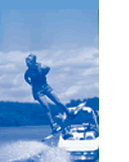
|
HISTORY
|
|
Wakeboarding is a dynamic watersport that started in the late 80's, and today is the fastest-growing board sport world-wide. Akin to snowboarding, the sports popularity is spreading like wildfire around the globe. Evolving from a combination of surfing, snowboarding, skating and waterskiing, wakeboarding is not only the world's fastest-growing water board sport but also the most accessible. You can enjoy Wakeboarding on lakes , rivers or on the sea. Riders are able to perform awesome BIG AIR tricks, whilst being towed behind a boat, with the use of larger wakes. The rider stands sideways on a shorter, wider board similar in concept to a snowboard. By travelling at a lower speed than in waterskiing and by carrying extra weight (and a compliment of cheering friends), the boat kicks up a big wake. The rider uses this wake as a launch ramp where a variety of tricks are performed. These can range from skate/snowboard inspired grabs and spins to massive flips and soaring jumps. In the same way that snowboarding has brought a cultural revolution to the snowski market, wakeboarding has redefined and reinvented waterskiing. What was once a sport enjoyed by a small group of pioneering individuals, wakeboarding is now a hugely popular global pastime with its own unique attitude and style. Because of its emphasis on freestyle creativity, wakeboarding has an attitude, exuberance and energy that is synonymous with its irreverent style and cultural position. Like other exciting, technically progressive sports taken up by forward thinking trend-setters, wakeboarding has many followers who don't necessarily practice the sport but really get into the spirit and flavour of its lifestyle. In wakeboarding there are no hard landings to put off the beginners from learning or the professionals from pushing their personal limits to invent new tricks. Legend has it that Wakeboarding was Invented in 1979 by Tony Finn in California, the 'skurfer' was born out of surfing frustration. When there were no waves, the surfers could get towed behind a loaded-up speedboat whose increased wake provided some surfstyle relief. In those days, the lumbering 'skurfer' would be surfed on the wake, but as the years went by, lighter more maneuverable symmetrical boards were developed and the wake's role changed from wave to launch ramp. In the early nineties, the sport now known as 'wakeboarding' encompassed influences from snowboard and skate scene. Over the course of the last 5 years we have seen the introduction of obstacles such as sliders, funboxs, kickers and flat bars. This adds another dimension and element to the sport, similar to skate and snowboard, with floating or fixed obstacles in the course. and more recently by the growing snowboard and skate scene. The sport made its appearance in Europe in the early to mid-eighties, with the French surfers and snowboarders riding on the sea in the French Riviera. The sport has since grown rapidly worldwide and enjoys massive media coverage with events being held in exotic locations around the world.
|
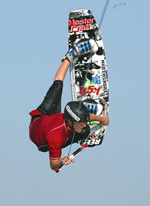 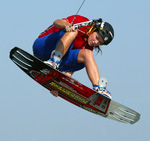 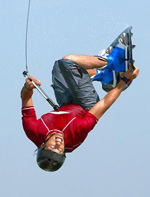 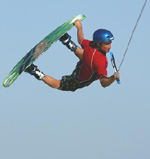 |

